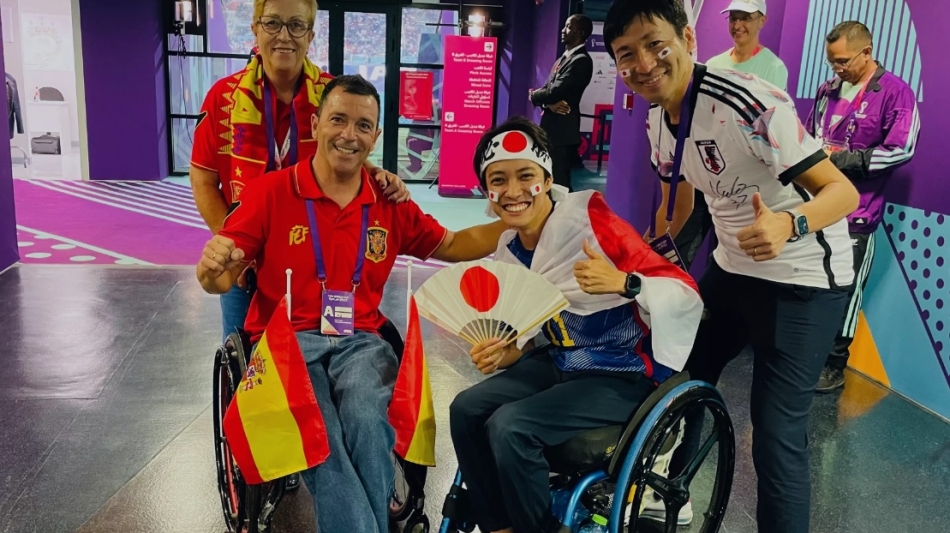Doha: Executive Director, Community Engagement and Commercial Development at the Supreme Committee for Delivery and Legacy (SC) Khalid Al Naama said the availability and ease of access and movement were at the forefront of priorities during the preparation phase to host the FIFA World Cup Qatar 2022, in line with the Qatar National Vision 2030 and FIFA Sustainability Strategy.
Al Naama said in Press statements on the eve of the celebration of the International Day for People with Special Needs, corresponding to December 3 of each year: “Our commitment to accessibility has been part of our planning for the tournament from the very beginning. By working with the Accessibility Forum, we ensured that disabled people played a direct role in determining what type of services are available to them during the tournament, and how the World Cup can leave a long-lasting accessible legacy for the country and the region as a whole.”
FIFA's Head of Sustainability & Environment, Federico Addiechi said, “For each edition of the FIFA World Cup, we step up our commitment to sustainability. Qatar 2022 is becoming a standard bearer for other major sporting events when it comes to accessibility, going beyond basic infrastructure. This is about ensuring that every fan feels welcome and a part of this event, and we are proud of what we have achieved.”
Working with local stakeholders, the SC, FIFA and FIFA World Cup Qatar 2022 LLC has set up sensory rooms for fans with access requirements at three Qatar 2022 stadiums: Al Bayt, Lusail and Education City.
The spaces allow fans to watch matches in a quieter space, equipped with assistive technology and managed by expert staff. This edition of the FIFA World Cup has included the largest deployment of sensory rooms at a mega sporting event in history.
A number of mobile sensory rooms have also been set up across Qatar to give fans the opportunity to step away from large crowds or loud music. Locations include the Corniche, where the SC has organized a vast number of cultural activations, and the FIFA Fan Festival at Al Bidda Park.
For Yassine Chahboub, it has been a lifelong dream to attend the FIFA World Cup. However, the 30-year-old Morocco fan has sensory needs that make it difficult for him to attend live matches. Big crowds, loud fans and bright lights can be overwhelming for Chahboub but thanks to the availability of sensory rooms at Qatar 2022, his dream has become reality.
“I never thought I'd be able to support my team from the stands, especially at a World Cup. When I heard that Qatar is offering quiet spaces which I can retreat to if everything becomes too much, I immediately booked my tickets,” said Chahboub, who flew to Qatar from Budapest with his lifelong friend, Badre Bedrkich.
For Adel Al Awad, bringing his 13-year-old brother Ibrahim to a FIFA World Cup match is an important experience.
“I am delighted to see Ibrahim being given the opportunity to attend football matches. He loves the game, and is always excited when we go to the stadium. Although he loves the sights and sounds of being in the stands, they can sometimes be a bit too much for him. As a child with Autism, his senses can be overloaded, but these sensory rooms make the experience very manageable.
“More importantly, these types of facilities give Ibrahim the opportunity to experience large events and gain the confidence to be better integrated in social settings.”
The SC, FIFA and FIFA World Cup Qatar 2022 LLC have worked together closely to priorities accessibility throughout tournament preparations, in line with the FIFA Sustainability Strategy.
The SC launched the Accessibility Forum in 2016, with members playing an active role in providing feedback on the SC's infrastructure projects, working towards meeting FIFA Accessibility and inclusive design standards while helping to drive the accessibility agenda in Qatar.
In addition to sensory rooms, Qatar 2022 also features a number of firsts for disabled fans, including the availability of audio descriptive commentary in Arabic at all matches. The tournament is also being hailed as the most accessible edition of the FIFA World Cup in history with all eight stadiums being outfitted with facilities for disabled fans.
Source: QNA


